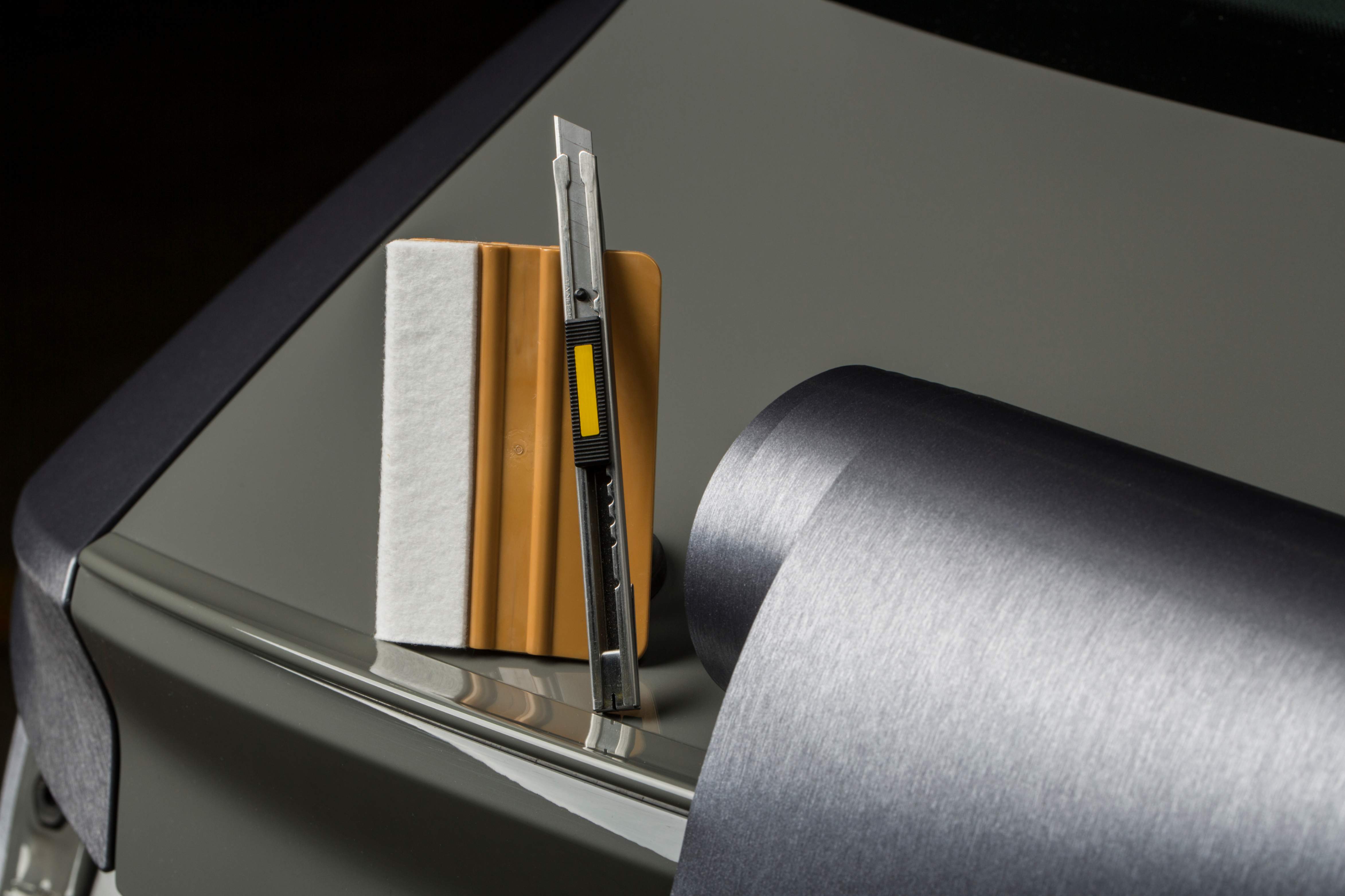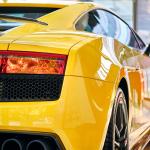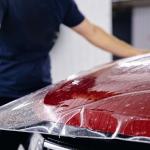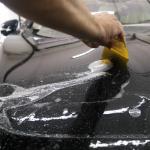Manual
Exploration
1 Welcome to Lavra Paint Protection Film (PPF), your premium tool for protecting valuable vehicles. As an installer, your first step is to familiarize yourself with the PPF. Through hands-on interaction, you will appreciate its flexibility and adaptability to diverse vehicle surfaces, along with the distinctive stickiness that ensures a firm yet non-damaging adhesion. This initial exploration is a critical part of mastering the PPF application. Understanding how the film behaves, from its stickiness to its stretching capabilities, plays a vital role in efficient and effective installations. Embrace the world of Lavra PPF, where becoming well-versed with the material is the key to providing superior protection for every vehicle.
Surface prep
2 The success of any Lavra Paint Protection Film (PPF) application largely depends on the thorough preparation of your vehicle's surface. This crucial step ensures optimal adhesion of the PPF, providing the highest degree of protection. Here are the key steps in the preparation process:
Clean the Surface: Start with a comprehensive wash of your vehicle using high-quality car shampoo to remove dirt, grime, and other surface contaminants. Pay special attention to edges, crevices, and hard-to-reach areas where dirt often accumulates. After washing the vehicle, it is essential to remove water residue in gaps using compressed air.
Clay Bar Treatment: After washing, a clay bar treatment is recommended. This procedure extracts any microscopic contaminants that are still clinging to the vehicle's surface, ensuring a smooth, clean base for the PPF.
Polishing: For optimal results, consider polishing your vehicle. Polishing further smoothens the surface and enhances the paint's gloss, providing an ideal canvas for the PPF.
Isopropyl Alcohol Wipe: Lastly, wipe down the surface with a 91% isopropyl alcohol solution. This important step ensures the complete removal of residual oils, waxes, or any contaminants that could interfere with the PPF's proper adhesion to the surface.
Surface Check: Before beginning the PPF application, inspect the vehicle thoroughly for any remaining contaminants or rough spots. The surface should be impeccably smooth to the touch as any imperfections can show through the PPF, affecting the final appearance.
Remember, the key to a successful, professional-looking Lavra PPF installation lies in meticulous preparation. A perfectly clean and smooth surface is critical for achieving the best results. With Lavra PPF, you're not just protecting your vehicle but also significantly enhancing its overall aesthetic appeal.
Conditions
We appreciate your interest in our Paint Protection Film (PPF) installation. For optimal results, PPF installation needs to occur in a controlled environment, with specific conditions fulfilled. Please find these details outlined below:
Temperature: PPF application should ideally be performed in a climate-controlled environment. The recommended room temperature ranges between 70 and 75 degrees Fahrenheit (approximately 21 to 24 degrees Celsius). This range ensures the film's adhesive activates correctly for optimal adherence. If the temperature is too low, the film might not adhere properly, and if too high, it might adhere too quickly, which can compromise the installation process.
Humidity: For optimal application, the relative humidity in the room should ideally be below 50%. High humidity can hinder the proper curing of the adhesive and may impact the overall quality of the film installation.
Clean Environment: It's important to ensure the PPF application area is clean and dust-free. Any dust or particles can potentially get trapped under the film, leading to visible imperfections and may reduce the lifespan of the product.
Lighting: Proper lighting is essential during the application process to enable the clear sighting of any contaminants on the paint surface, and to ensure accurate placement of the PPF.
By adhering to these environmental conditions, we can provide you with the best possible PPF installation for your vehicle, providing a durable and high-quality finish with superior protection.
Tools
We greatly appreciate your interest in our LAVRA Paint Protection Film (PPF) installation services. Our topmost priority is to provide exceptional service to you and optimum protection to your vehicle. The precision and attention to detail required in this process are accomplished using an array of carefully selected tools. Here's a more detailed overview:
Professional Cleaning Supplies: The first step in the installation process involves cleaning your vehicle meticulously. We use professional-grade cleaning solutions, ensuring that every speck of dirt and debris is removed. Specialized clay bars are employed to lift any contaminants embedded in the paint. We finish the cleaning process with the use of ultra-soft microfiber towels to prevent any micro-scratches, guaranteeing a pristine surface for film application.
Specialized Squeegees: Ensuring a smooth, flawless application of the LAVRA PPF requires a range of squeegees, each specifically designed to adapt to various contours and surfaces of your vehicle. These tools help us eliminate air bubbles and potential creases, ensuring seamless adherence of the film to the surface of your vehicle.
Precision Utility Knife and Blade: Precision is key during the film cutting process. We use utility knives with high-quality blades for accurate trimming of the film. These tools allow us to deliver exact cuts without posing any risk of damage to your vehicle's paint.
Heat Gun or Torch: To shape the film around the intricate curves and corners of your vehicle, we utilize professional-grade heat guns or torches. These tools provide controlled heat, which allows us to stretch and mold the film to match your vehicle's unique dimensions and design details perfectly.
Slip Solution Spray Bottles: To enable smooth positioning and adjusting of the film during installation, we use a specially formulated slip solution. It's applied using spray bottles, creating a lubricating layer that allows us to maneuver the film with precision and ease.
Detailing Tape: This tool plays an essential role in protecting the adjacent areas that aren't being worked on, and it assists in keeping the film precisely in place during the installation process. Our use of professional detailing tape ensures that every part of your vehicle is treated with utmost care.
Installation Gloves: To prevent any fingerprints or unwanted oils from compromising the adhesive side of the film, our installers use specialized gloves. These ensure that the film remains pristine throughout the installation process.
Plotter (Optional): For an even more precise fit, we can employ a plotter. This advanced tool uses specific software to pre-cut the PPF, avoiding the need for manual cutting on the car, which guarantees absolute precision and protects your car's paintwork.
Our professional and meticulous approach to LAVRA PPF installation ensures not just a high-quality application but a superior finish. This results in a durable protection for your vehicle that both preserves its appearance and its value. Your satisfaction is our commitment, and we're here to assist you every step of the way.
Installation Liquids
Water: For optimal results, we advise the use of distilled or purified water in your installation process. Regular tap water often contains excessive quantities of dissolved minerals such as Iron and Calcium which could negatively impact both the installation process and the aesthetics of the finished film.Slip Solution: We recommend Johnson Baby Shampoo or any other neutral soap devoid of additives like moisturizers, as these could leave undesirable, cloudy residues under the film.
As far as soap solutions are concerned, the ideal mixture depends on the temperature.
For colder weather, between 15°-23°C (60°-74°F), we advise the addition of 2-3 drops (less than 0.5ml) of soap per 32-ounce spray bottle. In contrast, during warmer weather, at temperatures of 24°-32°C (75°-90°F), you should aim for 4-5 drops (less than 1ml) of soap per 32-ounce spray bottle.
Although some paint protection films in the market may necessitate higher quantities of soap during installation, this is not advisable for our Lavra product. Using more soap than suggested can lead to excessive sliding and potentially compromise adhesion. Hence, we recommend adhering to our suggested soap levels for optimal installation results.
Tuck Solution: As for the Alcohol (Tack) solution, we recommend the use of isopropyl alcohol, which is conveniently available at any pharmacy or grocery store. You can typically find it in 70% or 90% grades - both are suitable for our purposes. However, be cautious to dilute the alcohol with water according to the instructions below, as applying undiluted alcohol to the adhesive may lead to cloudiness.
Our recommended ratio for the tack solution is 90% water to 10% alcohol. If more tack is required, you can adjust the alcohol concentration to be 20%, with water making up the remaining 80%. However, we strongly discourage any concentrations of alcohol higher than 20% since it can damage the adhesive.



